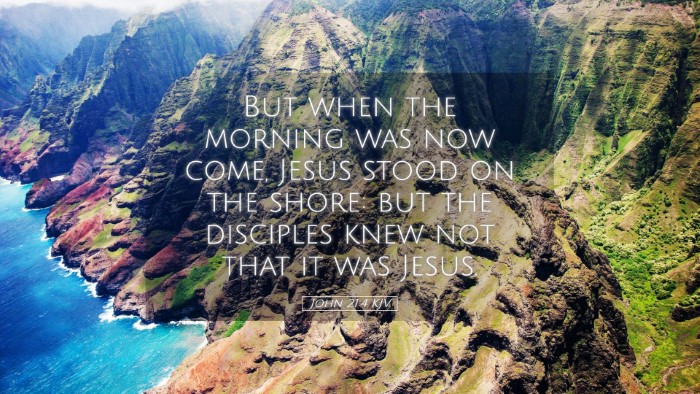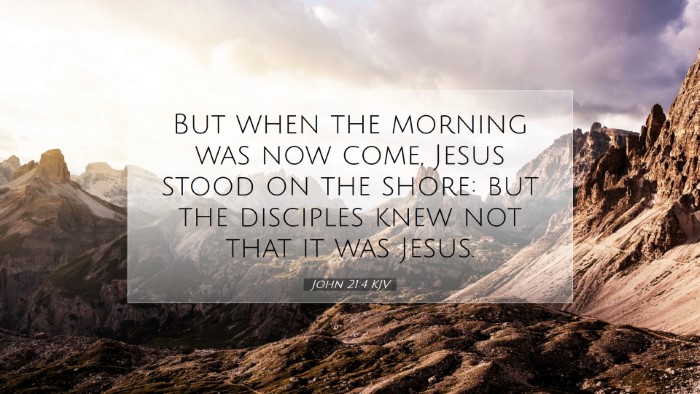Old Testament
Genesis Exodus Leviticus Numbers Deuteronomy Joshua Judges Ruth 1 Samuel 2 Samuel 1 Kings 2 Kings 1 Chronicles 2 Chronicles Ezra Nehemiah Esther Job Psalms Proverbs Ecclesiastes Song of Solomon Isaiah Jeremiah Lamentations Ezekiel Daniel Hosea Joel Amos Obadiah Jonah Micah Nahum Habakkuk Zephaniah Haggai Zechariah MalachiJohn 21:4
John 21:4 KJV
But when the morning was now come, Jesus stood on the shore: but the disciples knew not that it was Jesus.
John 21:4 Bible Commentary
Commentary on John 21:4
Verse Text: "But when the morning was now come, Jesus stood on the shore: but the disciples knew not that it was Jesus."
Exegesis and Context
This passage is located at the conclusion of the Gospel of John, wherein we find the resurrected Christ revealing Himself to His disciples. The timing of this event, occurring "when the morning was now come," signifies a new beginning—a theme prevalent throughout Scripture where morning often symbolizes divine revelation and hope.
Theological Implications
According to Matthew Henry, the illustration of the morning emphasizes the dawn of understanding and recognition among the disciples. The morning light represents not only physical illumination but also spiritual awakening. It serves as a picture of the resurrection, where Christ brings light into the darkness of despair and ignorance. The disciples’ failure to recognize Jesus reflects the common human condition of spiritual blindness, especially to the divine truth that surrounds us.
Historical Context
Albert Barnes discusses the historical context of this appearance, noting that the disciples had returned to their former profession of fishing after Jesus’ crucifixion. Their uncertainty about their calling is evident. This return signifies a moment of trust in their old ways amidst confusion regarding their new identity as followers of Christ.
Symbolism of the Shore
The shore on which Jesus stands is rich in symbolism. Adam Clarke comments that the shore represents a boundary between the known and the unknown. It is a place where the sea of their former life and the land of their new calling intersect. The disciples, accustomed to the waters, find themselves again confronted by Jesus, calling them back to a greater purpose.
The Nature of Recognition
One of the profound elements within this verse is the disciples’ inability to recognize Jesus. This duality of presence and perception is central to many biblical accounts of divine encounters. Both Henry and Barnes note that this moment serves as a metaphor for the spiritual journey; often, we may stand in the presence of Jesus yet fail to perceive who He truly is. The disciples’ role here serves as a reminder for believers today to seek discernment and awareness of Christ in their lives.
Application for Believers
For contemporary believers, this passage teaches the importance of vigilance and discernment in recognizing Christ’s presence. Pastors and theologians will find that this story can inspire congregations to remain alert and open to God's revelations in their daily lives and circumstances. The fact that Jesus stands patiently waiting demonstrates His grace and continual pursuit of humanity.
Concluding Thoughts
The complexities involved in this brief verse reveal significant truths about divine revelation, identity, and the call to obedience. This passage serves not only as a historical account but also as a pastoral exhortation for believers to engage actively with their faith, await revelations from Christ, and remain ready to respond to His call in their lives.
Further Reflections
- Awareness: Are we aware of Christ’s presence in our routines?
- Response: How do we respond to His call in moments of uncertainty?
- Renewal: What “mornings” do we seek to experience in our faith journeys?


